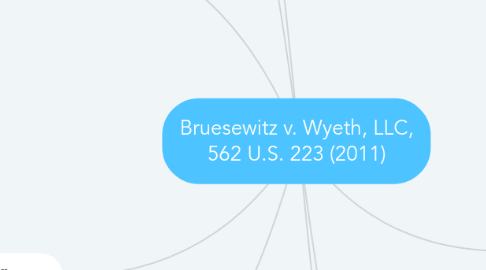
1. Issue
1.1. "Can a federal law shield vaccine manufacturers from certain product liability lawsuits in state court that seek damages for serious health problems suffered by children?"
2. Rule of Law
2.1. National Childhood Vaccine Injury Act protected Wyeth and other vaccine manufacturers from lawsuits over vaccine injury claims
3. Analysis/Application
3.1. Bruesewitz claims that drug company Wyeth did not develop a safe vaccine and should be held accountable for adverse side effects from their vaccine.
3.1.1. There was rising concern with DTP vaccines, which were blamed for children's disabilities and developmental delays. This led to a massive increase in vaccine-related tort litigation.
3.1.1.1. NCVIA was passed to help compensate victims of vaccine injury but also to shield vaccine manufacturers from liability for adverse side effects
3.1.2. Bruesewitz claims that defective design of DTP vaccine caused Hannah’s disabilities, and that Wyeth was subject to strict liability and liability for negligent design.
3.2. Case was dismissed due to protection from the NCVIA
3.2.1. "No vaccine manufacturer shall be liable in a civil action for damages arising from a vaccine-related injury or death associated with the administration of a vaccine after October 1, 1988, if the injury or death resulted from side effects that were unavoidable even though the vaccine was properly prepared and was accompanied by proper directions and warnings."
3.2.1.1. There was provision of significant tort liability protections for vaccine manufacturers.
3.2.1.1.1. The NCVIA “reflects a sensible choice to leave complex epidemiological judgments about vaccine design to the FDA and the National Vaccine Program rather than juries”
3.2.2. The NCVIA preempts all design-defect claims against vaccine manufacturers brought by plaintiffs seeking compensation for injury or death caused by a vaccine’s side effects.
3.2.2.1. Design defects were not mentioned in the Act because they are not a basis for liability.
3.2.3. "Provided that there was proper manufacture and warning, any remaining side effects, including those resulting from design defects, are deemed to have been unavoidable"
4. Influence
4.1. Drug companies and vaccine manufacturers are protected by the NCVIA
4.2. The compensation scheme created by NCVIA was a significant and necessary public health achievement.
5. Importance
5.1. The NCVIA of 1986 was a monumental act in public health legislation which emphasized the value of vaccinations but also eliminated manufacturer liability for a vaccine’s unavoidable, adverse side effects.
6. Facts
6.1. Parties
6.1.1. Russell/Robalee/Hannah Bruesewitz (Petitioners)
6.1.2. Wyeth, Inc., fka Wyeth Laboratories (Respondent)
6.2. What Happened
6.2.1. 1992: Hannah Bruesewitz started having seizures after receiving her diphtheria, tetanus and pertussis (DTP) vaccine, which was developed by Wyeth Laboratories
6.2.2. Hannah suffered over 100 seizures and was diagnosed with residual seizure disorder and developmental delay
6.2.3. 1995: Petitioners Russell and Robalee Bruesewitz filed a vaccine injury petition for compensation
6.2.4. Bruesewitz petition was denied due to new regulations eliminating the seizure disorder from the list of compensable injuries
6.2.5. 1998: Drug company Wyeth withdrew vaccine from market
6.2.6. Bruesewitz files a lawsuit against Wyeth in state court in Pennsylvania.
6.3. Procedural History
6.3.1. "A federal judge dismissed the lawsuit, ruling that the National Childhood Vaccine Injury Act protected Wyeth from lawsuits over vaccine injury claims".
6.3.2. The U.S. Court of Appeals for the 3rd Circuit affirmed.
7. Impact
7.1. Cedillo v. Sec’y of Health and Human Services
7.1.1. Similar case in which Cedillos alleged that the measles-mumps-rubella (MMR) vaccine caused their daughter to suffer from various medical conditions, including autism
7.2. Hazlehurst v. Sec’y of Health and Human Services,
7.2.1. Similar case in which Hazlehursts alleged that the MMR vaccine, caused their son to develop regressive autism

